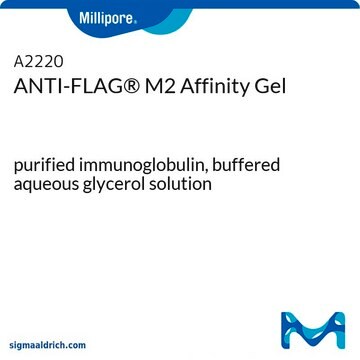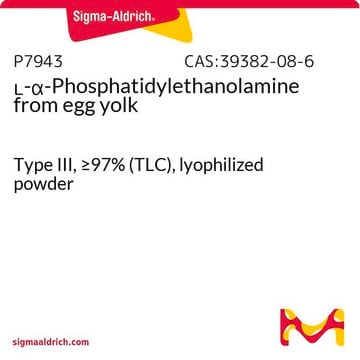Phosphatidylserine is important in enzymatic assays of purified protein kinase C. During activation of this enzyme, as part of the signal transduction process, phosphatidylserine, which is located on the inside of cellular plasma membranes, binds to cysteine residue domains on protein kinase C. Phosphatidylserine can be used as a standard in thin-layer chromatography and for artificial membrane studies such as in lipsome research.
Wichtige Dokumente
P5660
3-sn-Phosphatidyl-L-serin Natriumsalz aus Rinderhirn
≥95% (TLC)
Synonym(e):
1,2-Diacyl-sn-glycero-3-phospho-L-serine, L-α-Phosphatidyl-L-serine sodium salt
Größe auswählen
Größe auswählen
About This Item
Empfohlene Produkte
Assay
≥95% (TLC)
Form
powder
Lagertemp.
−20°C
SMILES String
[Na+].CCCCCCCCCCCCCCCCCC(=O)OC[C@H](COP(O)(=O)OC[C@H](N)C([O-])=O)OC(=O)CCCCCCCCCCCCCCCCC
InChI
1S/C42H82NO10P.Na/c1-3-5-7-9-11-13-15-17-19-21-23-25-27-29-31-33-40(44)50-35-38(36-51-54(48,49)52-37-39(43)42(46)47)53-41(45)34-32-30-28-26-24-22-20-18-16-14-12-10-8-6-4-2;/h38-39H,3-37,43H2,1-2H3,(H,46,47)(H,48,49);/q;+1/p-1/t38-,39+;/m1./s1
InChIKey
SJRBMGBLPUBGJL-MBAWARMDSA-M
Allgemeine Beschreibung
Anwendung
Biochem./physiol. Wirkung
Vorsicht
Angaben zur Herstellung
Lagerklassenschlüssel
11 - Combustible Solids
WGK
WGK 3
Flammpunkt (°F)
Not applicable
Flammpunkt (°C)
Not applicable
Persönliche Schutzausrüstung
Eyeshields, Gloves, type N95 (US)
Hier finden Sie alle aktuellen Versionen:
Analysenzertifikate (COA)
Die passende Version wird nicht angezeigt?
Wenn Sie eine bestimmte Version benötigen, können Sie anhand der Lot- oder Chargennummer nach einem spezifischen Zertifikat suchen.
Besitzen Sie dieses Produkt bereits?
In der Dokumentenbibliothek finden Sie die Dokumentation zu den Produkten, die Sie kürzlich erworben haben.
Kunden haben sich ebenfalls angesehen
-
What is Product P5660, 3-sn-Phosphatidyl-L-serine sodium salt, commonly used for?
1 answer-
Helpful?
-
-
Is 3-sn-Phosphatidyl-L-serine sodium salt from bovine brain available in solution?
1 answer-
Yes. Product No. P6641 is a ready-to-use solution of phosphatidylserine in a chloroform:methanol mixture.
Helpful?
-
-
Do you have any inhibitors for Protein Kinase C (PKC)?
1 answer-
Yes. Two examples are Product No. C6303 (Calphostin C from Cladosporium cladosporioides) and Product No. C2932 (Chelerythrine chloride).
Helpful?
-
-
What is the Department of Transportation shipping information for this product?
1 answer-
Transportation information can be found in Section 14 of the product's (M)SDS.To access the shipping information for this material, use the link on the product detail page for the product.
Helpful?
-
-
What is the molecular weight of Product P5660, 3-sn-Phosphatidyl-L-serine sodium salt from bovine brain?
1 answer-
The molecular weight of this compound is approximately 812.1 g/mole. This molecular weight assumes that stearoyl and oleoyl are the prodimant fatty acids in the compound. Phosphatidylserine may have a number of different fatty acid residues associated with it. Our analyses of multiple lots of phosphatidylserine identified average fatty acid percentages of approximately 40% for stearic acid and 30% for oleic acid.
Helpful?
-
-
What is Product P5660, 3-sn-Phosphatidyl-L-serine sodium salt from bovine brain, soluble in?
1 answer-
This product is soluble in chloroform:methanol (95:5 v/v) at a concentration of 50 mg/mL. It will likely form a suspension or emulsion in deionized water at a concentration of 1 mg/mL or higher.
Helpful?
-
-
What is the solution stability of Product P5660, 3-sn-Phosphatidyl-L-serine sodium salt from bovine brain?
1 answer-
Solutions can be divided into aliquots and stored at -20 °C. We have no information as to how long the solutions will be stable. Solution stability is enhanced when the compound is protected from oxygen, because the unsaturated fatty acids are subject to oxidation. To protect from oxidation, dissolve the compound in solvents in which oxygen has been removed and replaced with an inert gas such as nitrogen or argon.
Helpful?
-
Active Filters
Unser Team von Wissenschaftlern verfügt über Erfahrung in allen Forschungsbereichen einschließlich Life Science, Materialwissenschaften, chemischer Synthese, Chromatographie, Analytik und vielen mehr..
Setzen Sie sich mit dem technischen Dienst in Verbindung.








